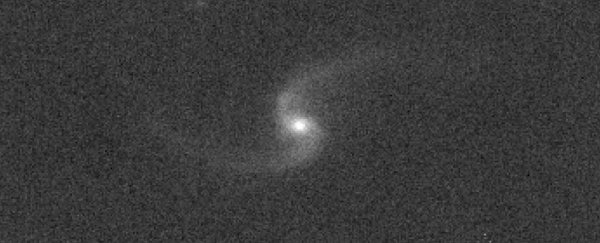Last year, the LIGO and Virgo gravitational wave detectors pinged with an entirely new kind of collision: not two neutron stars, not two black holes, but a neutron star and a black hole together. Scientists were thrilled: this could be the first time we've ever witnessed such a binary system.
Now, after poring over the corner of space in which the collision took place, an international team of astronomers has seen the aftermath - or rather, the lack of one.
Using some of the world's most powerful astronomical instruments, the ElectromagNetic counterparts of GRAvitational wave sources at the VEry Large Telescope (ENGRAVE) collaboration found not even a brief flash of light associated with the collision. Their research awaits peer review, and has been published on pre-print server arXiv.
Now, this doesn't mean that the event, called S190814bv, didn't take place. It doesn't even mean there was absolutely no flash of electromagnetic radiation - what is called the "electromagnetic counterpart" to a gravitational wave detection.
What it does mean is that astronomers have a little more information - the beginnings of a database that will help us to learn more about these elusive mergers in the future. And it may allow scientists to place some tentative constraints on the aftermath of a black hole devouring a neutron star - if that's what the event really was.
"We don't clearly identify a counterpart," physicist Morgan Fraser of University College Dublin in Ireland told ScienceAlert.
"This could mean that either: there was no counterpart (perhaps the black hole swallowed the neutron star whole); there was a counterpart but it was too faint for us to detect; [or] there was a counterpart that we missed (perhaps one of the transients that we see in the field and ruled out was in fact what we were looking for)."
It's still not entirely clear what the event was - analysis is still being performed on the gravitational wave data. But those data suggest the collision was between an object below three times the mass of the Sun, and another over five times the mass of the Sun.
Both neutron stars and black holes are the ultradense remains of dead stars, but we've never seen a black hole smaller than 5 solar masses, or a neutron star larger than around 2.5 solar masses.
So S190814bv - which had an extremely low false alarm rate - could very well be that elusive neutron star-black hole binary collision. An electromagnetic counterpart as the black hole pulls apart the neutron star could have shown us something we know relatively little about - what's actually inside a neutron star.
Alas, it wasn't to eventuate. Even though the S190814bv gravitational wave signal was strong, finding this hypothetical flash of light from so far away - around 800 million light-years - was not such a simple task.
Not only did the ENGRAVE team return a null detection, so too did the Australian Square Kilometre Array Pathfinder, searching the radio spectrum; the GROWTH collaboration, searching optical and near-infrared; and the Observatorio Astronómico Nacional in Mexico, searching for gamma radiation.
"[S190814bv is] really at the upper limit of the distant range where we can hope to detect emission," Fraser explained.
And that's not the only problem - even with more powerful tools that could detect fainter flashes, we'd need to find a way to distinguish the electromagnetic counterpart from all the other transients in the same corner of space.
"It's not just a matter of detecting the counterpart, it's how to pull this needle out of a giant haystack of supernovae from exploding stars, flares from the nuclei of galaxies, eruptions on the surface of stars and more," Fraser told ScienceAlert.
The team did that as thoroughly as they could - but there's still a chance that the event was just too faint, and still a chance that one of the transient events they discarded was actually from the merger.
It's also possible that the neutron star wasn't shredded until after it was already inside the black hole's event horizon - preventing any light from escaping out of the black hole.
And even if S190814bv wasn't a neutron star and a black hole, there is still something to learn. Astronomers are also avidly hunting for what is called a "mass-gap" event, where one or both of the colliding bodies is in-between the upper mass limit of neutron stars (2.5 solar masses) and the lower limit of black holes (5 solar masses).
We may not be able to learn if what sits in this gap is a tiny black hole or a chunky neutron star from the data collected on S190814bv. But the team has demonstrated that their collaboration works, and they are ready and waiting to collect the next round of observations, and the next, and the next after that.
"What we have demonstrated here is that we can make a search of a significant fraction of the region associated with a gravitational wave at this distance, and that we can put some useful limits on any potential counterpart," Fraser said.
"Finding the counterparts of gravitational waves is an immense challenge, and in this case we didn't see anything. But with what we've learned, we are even more prepared for the next one the Universe gives us!"
The research has been submitted to Astronomy & Astrophysics, and is available on arXiv.
